Light: Mirrors and Lenses Chapter Notes | Chapter Notes For Class 8 PDF Download
| Table of contents |

|
| What Are Spherical Mirrors? |

|
| What Are the Characteristics of Images Formed by Spherical Mirrors? |

|
| What Are the Laws of Reflection? |

|
| What Is a Lens? |

|
| Key Points to Remember |

|
Have you ever wondered why the warning “Objects in mirror are closer than they appear” is written on the side-view mirrors of cars? Or why reading glasses sometimes have a curved line on their lenses?
Let’s explore these questions with Meena! On a sunny afternoon during her summer holidays, Meena visited a science centre. Among all the amazing displays, something unusual caught her eye—a row of curved mirrors. 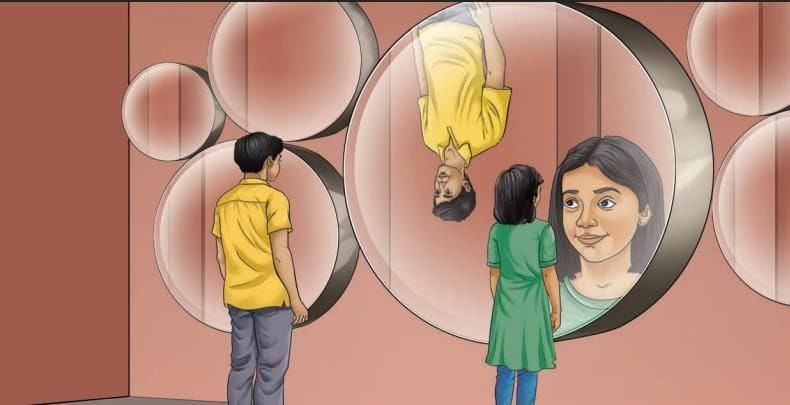 MirrorsTo her surprise, when she looked into one, her face seemed comically large, while her brother, just a little farther away, looked upside down! At another mirror, she saw a tiny version of herself staring back.
MirrorsTo her surprise, when she looked into one, her face seemed comically large, while her brother, just a little farther away, looked upside down! At another mirror, she saw a tiny version of herself staring back.
Why do mirrors behave this way? Through the world of spherical mirrors and lenses, get ready to discover the secrets of light and learn how mirrors can make images appear bigger, smaller, or even flipped around!
What Are Spherical Mirrors?
Spoon as a Mirror—A Simple Observation
- A shiny metallic spoon can act like a mirror. You can see your face in it if you hold it close.
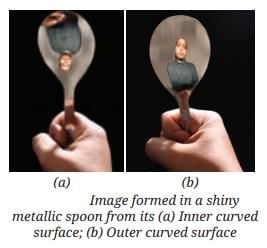
- If you look at the inner (curved inward) side of the spoon, your image appears inverted (upside down).
- If you look at the outer (bulging outward) side, your image appears erect (upright) but much smaller than your real face.
- This difference occurs because each side of the spoon curves in a different way, mimicking different types of curved mirrors.
Curved Mirrors and Spherical Mirrors
- Mirrors like your spoon can be specially made as curved mirrors for scientific and everyday use.
- The most common type of curved mirror is the spherical mirror.
Definition of Spherical Mirrors:
Spherical mirrors are mirrors whose reflecting surfaces are shaped like a part of a hollow glass sphere. Reflecting surfaces of spherical mirrors can curve either inwards or outwards.
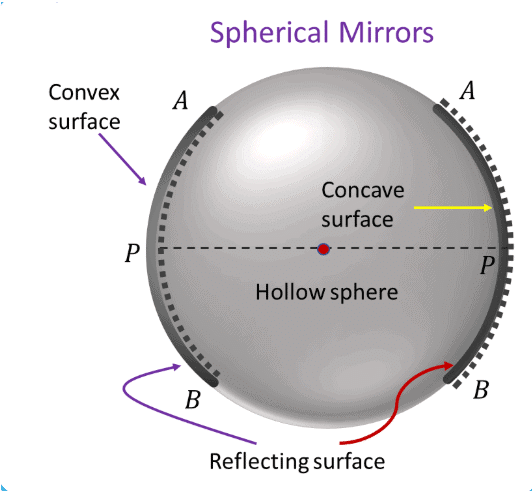
Types of Spherical Mirrors
1. Concave Mirror
- A mirror whose reflecting surface is curved inwards, like the inside of a spoon or a bowl..
- Edge bulges out, center dips in — think “cave.”
- The outline of this mirror is part of a circle when viewed from the front.
2. Convex Mirror
- Reflecting surface curves outwards (like the outer side of a spoon, or the back of a bowl).
- Center bulges out, edge curves back.
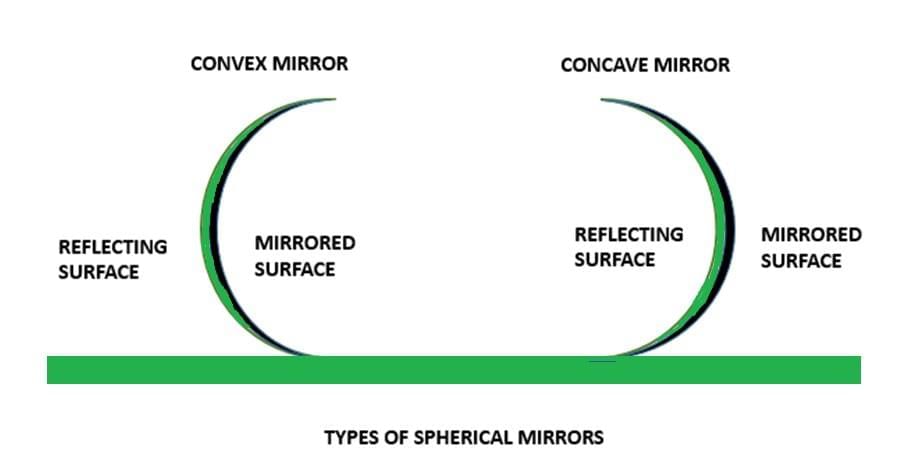
How Spherical Mirrors Are Made?
- Shape: Spherical mirrors have a shape as if they are parts of an imaginary hollow sphere.
- Manufacture: Despite their shape, these mirrors are not made by slicing a real hollow glass sphere.
- Process: They are actually made by grinding and polishing a flat piece of glass into a curved surface. Then, a reflective coating (like a thin layer of aluminum) is added.
Placement of Reflective Coating:
- If the coating is placed on the outer curved surface, the result is a concave mirror.
- If the coating is placed on the inner curved surface, the result is a convex mirror.
What Are the Characteristics of Images Formed by Spherical Mirrors?
Concave Mirror:
- When object is close (small distance): Image is erect but larger (enlarged) than the object.
- When object moves farther: Image becomes inverted. It starts enlarged but gets smaller as distance increases.
Convex Mirror:
- At any distance: Image is always erect and smaller (diminished) than the object.
- As object moves farther: Image size decreases slightly.
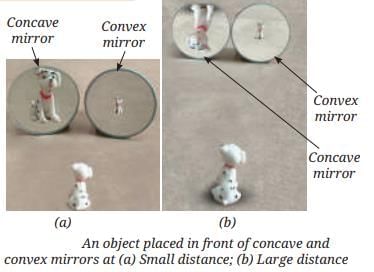
Common in Both: Lateral inversion (left-right reversal) is observed in the images.
Comparison to Plane Mirrors:
- Spherical mirrors differ from plane mirrors.
- Plane mirrors always form an erect image of the same size as the object.
- In concave and convex mirrors, image size changes with object distance.
- In concave mirrors, images also invert when the object is moved away.
Distinguishing Spherical Mirrors
Idea: Identify if a mirror is plane, concave, or convex by observing object images.
Concave: Enlarged erect image close up, inverted when far.
Convex: Always erect and diminished.
Plane: Always erect and same size.
Real-Life Uses of Spherical Mirrors
Concave and convex mirrors are used in everyday surroundings.
Concave Mirrors: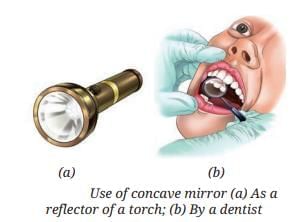
- Reflectors in torches, car headlights, and scooters (concave shape).
- Dental mirrors used by dentists: Provide enlarged view of teeth when held close inside the mouth.
Convex Mirrors: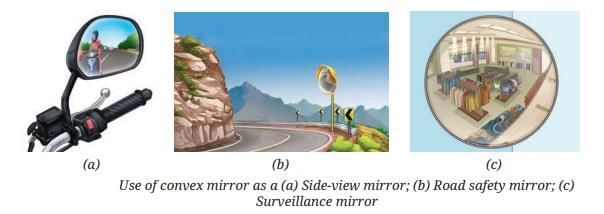
- Side-view mirrors on vehicles: Form erect, smaller images of traffic behind; curved outward for wider road view.
- Installed at road intersections or sharp bends: Provide visibility from both sides to prevent collisions.
- Used in big stores: Monitor large areas to deter thefts.
Telescopes
- Most modern telescopes are reflecting telescopes using curved mirrors.
- The main mirror is a large concave mirror.
What Are the Laws of Reflection?
Reflection is the bouncing back of light from a surface, like a mirror. The laws of reflection explain how light behaves when it strikes any mirror—plane (flat), concave (curved inward), or convex (curved outward).
The Two Laws of Reflection
1. First Law of Reflection: Angle of Incidence Equals Angle of Reflection
Definition: The angle at which the incoming light ray hits the mirror (angle of incidence, i) is equal to the angle at which it bounces off (angle of reflection, r). In symbols: i = r.
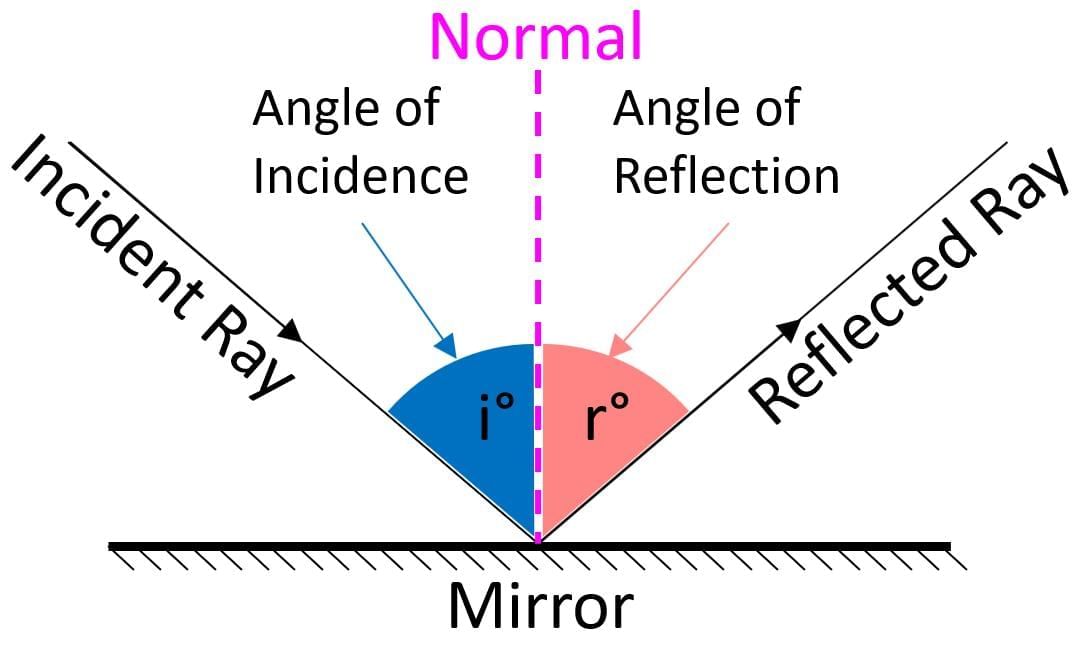 First Law of Reflection
First Law of Reflection
Key Concepts from Setup:
Use a plane mirror with stand, torch, comb (with black paper to make a thin slit), paper clip for holding, white paper sheet, and black paper strip.
Spread white paper on a table, place mirror upright, and shine a thin beam through the slit onto the mirror.
Adjust the beam to hit at different angles; the reflected beam shifts accordingly.
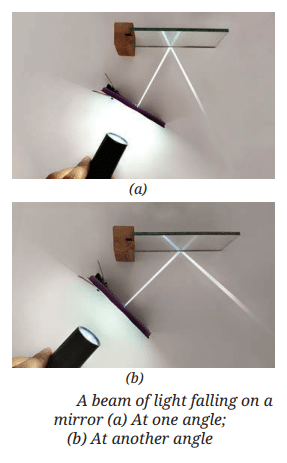
Terms to Remember:
Incident Ray: The incoming light ray that strikes the mirror.
Reflected Ray: The outgoing light ray that bounces back from the mirror.
Normal: An imaginary line drawn at 90° (right angle) to the mirror at the point of incidence.
Angle of Incidence (i): The angle between the incident ray and the normal.
Angle of Reflection (r): The angle between the reflected ray and the normal.
Light is represented as straight rays (lines with arrows) because light travels in straight lines.
How to Prove First Law of Reflection (Observation Process):
- Draw the mirror line, incident ray, reflected ray, and normal at point O.
- Measure i and r for different incident angles; record in Table.

- Special Case: If the incident ray is along the normal, both i and r = 0 (light bounces straight back).
- Inference (First Law): Measurements show i always equals r, no matter the incoming angle—this is the first law of reflection.
- Example: Shine a torch beam on a plane mirror at various angles—the bounce angle matches the incoming angle exactly.
2. Second Law of Reflection: All in the Same Plane
Definition: The incident ray, the normal to the mirror at the point of incidence, and the reflected ray, all lie in the same plane.
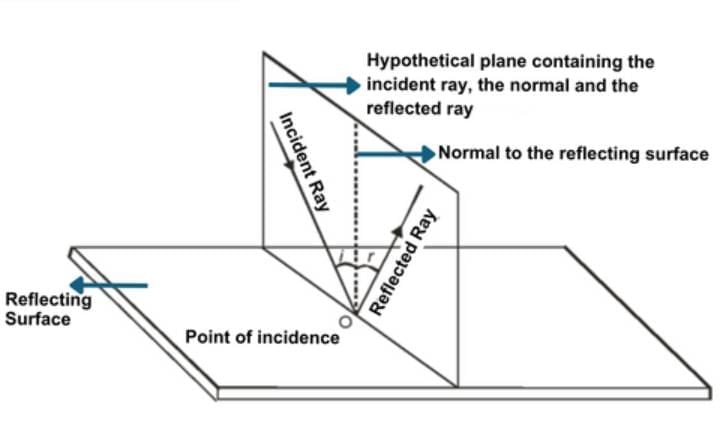
Key Concepts from Setup:
- Use the same materials as in activity above but add a stiff chart paper sheet extending beyond the table edge.
- Shine a beam on the mirror; see the reflected beam on the extended flat paper (Figure (a)).
- Bend the extended part down along the table edge; the reflected beam disappears (Figure (b)).
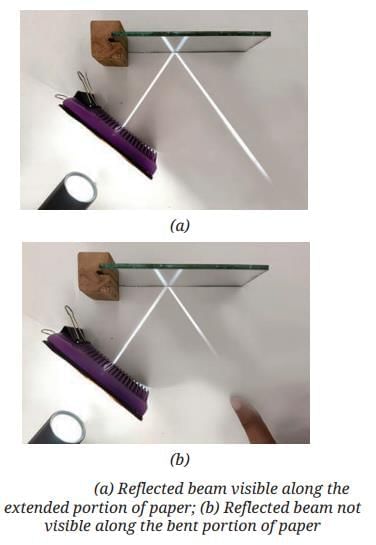
- Flatten the paper; the beam reappears.
- Inference (Second Law): Bending creates a new plane, breaking alignment—the law ensures the rays stay "flat" together for predictable reflection.
- Step Further: Even if incident rays come from different directions but hit the same point, the normal remains the same, and all (incident ray, normal, reflected ray) stay in one plane.
- Example: On flat paper, you see the full path; bending hides it because the plane changes.
How Laws Apply to Spherical Mirrors
The Laws Are Universal: Both laws (i = r and same plane) apply to all mirrors, including spherical ones.
Key Concepts from Setup: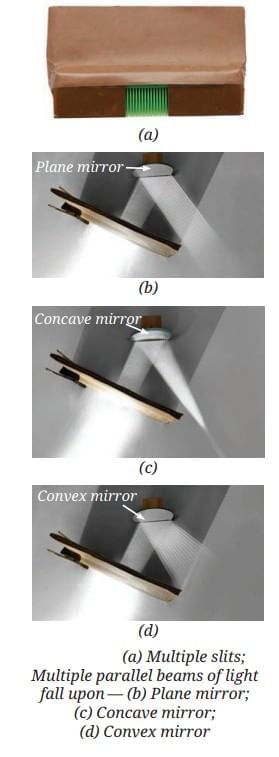
Use plane, concave, and convex mirrors with stands, torch, comb (multiple slits uncovered for parallel beams, and paper clip.
Shine parallel beams on each mirror one by one.
Observations:
Plane Mirror: Reflected beams stay parallel
Concave Mirror: Reflected beams come together (converge)
Convex Mirror: Reflected beams spread out (diverge).

Inference: Each ray obeys the laws, but the mirror's curve causes parallel rays to converge (concave) or diverge (convex)—this explains focusing or widening effects.
Concentrating Light with Concave Mirrors
Never look at the Sun or into the mirror reflecting sunlight—it can damage eyes. Focus light only on paper, not on faces or people.
Key Concepts from Setup:
Use a concave mirror and thin paper (e.g., newspaper).
Hold the mirror facing the Sun; direct reflected light onto the paper.
Adjust paper distance for a sharp bright spot.
Keep steady for a few minutes.
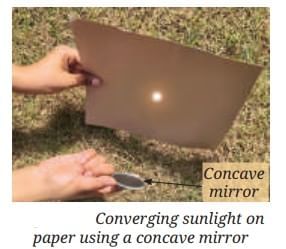
Observation: The paper starts burning and produces smoke.
Inference: Concave mirrors converge sunlight to a small point, creating intense heat that can ignite paper—this shows the power of focused reflection.
Step Further (Solar Concentrators): Devices using mirrors/lenses to focus sunlight for heating liquids, making steam for electricity, large-scale cooking, or solar furnaces (even melting steel). Recall electric furnaces from an earlier chapter.
What Is a Lens?
Imagine looking through a flat transparent glass window pane—all objects look the same size and shape. But if the surface of the transparent material is curved, objects may not look the same.
How a Water Drop Acts Like a Lens
Materials: A flat strip of glass or clear plastic (e.g., flat scale), few drops of oil, dropper, water, and a paper or book with printed text.
Key Concepts from Setup:
- Spread a few drops of oil (or wax) on the glass/plastic strip and rub to make a thin coating (helps water form a round drop).
- Use a dropper or finger to place a small water drop on the oiled/waxed spot.
Observations as Concepts:
- The water drop's surface is curved outward (not flat or curved inward).
- Place printed text under the strip so it's directly below the drop.
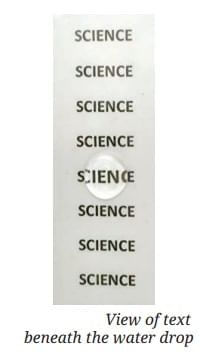
- Look down through the drop: Letters below appear different—often larger (enlarged) than nearby letters.
- Inference: The curved surface of the water drop changes the text's size, acting like a simple lens.
Definition and Types of Lenses
- A magnifying glass is a lens that enlarges small print, making letters look bigger.
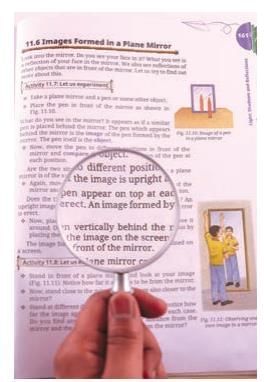
- Lens Definition: A piece of transparent material (usually glass or plastic) with curved surfaces.
- Lenses can be convex or concave, like mirrors.
- Convex Lens: Thicker at the middle than at the edges.
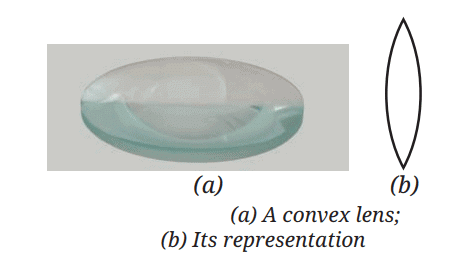
- Concave Lens: Thicker at the edges than at the middle.
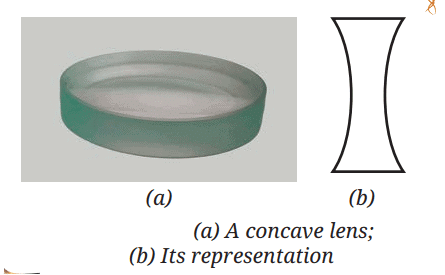
- Unlike mirrors, lenses allow light to pass through; we see things through a lens, not reflected in it.
How Objects Look Through Lenses
Materials: A convex lens, a concave lens, a lens holder, and a small object.
Setup:
- Place the lens upright in the holder.
- Put the object behind the lens (raise it to lens level if needed).
- Look through the lens from the other side.
- Move the object farther and observe changes; repeat for both lenses.
Observations :
Convex Lens:
- At small distance: Object appears erect and enlarged (larger).
- As distance increases: Object appears inverted; starts enlarged but gets smaller (diminishes).
Concave Lens:
- At any distance: Object always appears erect and diminished (smaller).
- Size changes (gets even smaller) as distance increases.
- Inference: Distance from the lens affects image size and orientation. Convex lenses can enlarge and invert; concave always diminish and keep erect.

Do Lenses Converge or Diverge Light?
Materials: A thin transparent glass plate, a convex lens, a concave lens, a torch and comb (for multiple parallel beams), paper clip to hold comb, two identical books, and white paper sheets.
Setup:
- Use books to hold the glass plate or lens upright between them .
- Spread paper on both books.
- Shine multiple parallel beams on the glass plate, convex lens, and concave lens one by one
Observations: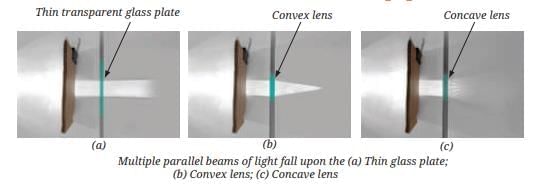
- Thin glass plate: Parallel beams pass through unchanged.
- Convex lens: Beams come together (converge).
- Concave lens: Beams spread out (diverge).
- Inference: Convex lenses are converging lenses (focus light); concave are diverging lenses (spread light). (Diagrams show rays passing through each.)
Drawing Light Through Lenses
Drawings of Activity show rays passing through: unchanged in glass plate, converging in convex lens, diverging in concave lens.

Can a Convex Lens Burn Paper?
Setup: Use a convex lens instead of a concave mirror in the path of sunrays.
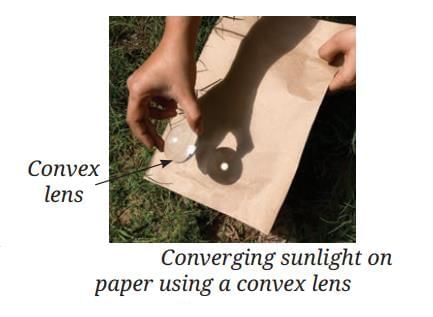
Observation: Yes, you can burn the paper—the lens converges sunlight to a hot point, like a concave mirror.
Inference: Convex lenses focus light to create heat, similar to converging mirrors.
Real-Life Uses of Lenses
- Lenses are important and used everywhere.
- Eyeglasses: Help people see clearly.
- Cameras, telescopes, and microscopes: Use lenses to capture or magnify images.
- Human eye: Has a convex lens that changes shape to focus on near (e.g., reading) or far objects.
Key Points to Remember
- Concave Mirror Images: A concave mirror forms images that can be bigger (enlarged), smaller (diminished), or the same size as the object. The image can be upright (erect) or upside down (inverted), all depending on how far the object is from the mirror.
- Convex Mirror Images: A convex mirror always forms images that are upright (erect) and smaller (diminished) than the object, no matter the distance.
- Laws of Reflection: These are two key rules for how light bounces off mirrors: (1) The angle where the light hits (angle of incidence) is equal to the angle where it bounces back (angle of reflection). (2) The incoming light ray, the normal line (straight up from the mirror at the hit point), and the bouncing ray all stay in the same flat surface (plane).
- Validity of Reflection Laws: The laws of reflection work the same way for every type of mirror, whether it's flat (plane), curved inward (concave), or curved outward (convex).
- Behavior of Mirrors with Light: A concave mirror brings light rays together (converges them), like focusing sunlight to make heat. A convex mirror spreads light rays apart (diverges them), giving a wider view.
- Convex Lens Images: A convex lens forms images that can be bigger (enlarged), smaller (diminished), or the same size as the object. The image can be upright (erect) or upside down (inverted), depending on how far the object is from the lens.
- Concave Lens Images: A concave lens always forms images that are upright (erect) and smaller (diminished) than the object, no matter the distance.
- Behavior of Lenses with Light: A convex lens brings light rays together (converges them), like in a magnifying glass. A concave lens spreads light rays apart (diverges them), like in some eyeglasses.
FAQs on Light: Mirrors and Lenses Chapter Notes - Chapter Notes For Class 8
| 1. What are spherical mirrors and how do they differ from other types of mirrors? |  |
| 2. What are the key characteristics of images formed by spherical mirrors? |  |
| 3. What are the laws of reflection and how do they apply to spherical mirrors? |  |
| 4. How do lenses differ from mirrors in terms of light behavior? |  |
| 5. What are some everyday applications of lenses in our daily lives? |  |




















